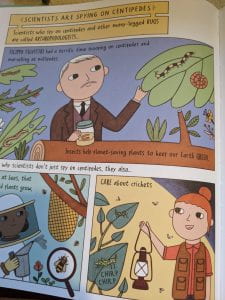In my role as chair of the SLA Information Book Awards I have the immense privilege to see an amazing collection of books every year. However, I am also aware that many people do not have access to many of these books, or even information on how to find them. That is why National Non-fiction November is so valuable and we should all be very grateful to the Federation of Children’s Book Groups, for all of the work they do in promoting this event.
information on how to find them. That is why National Non-fiction November is so valuable and we should all be very grateful to the Federation of Children’s Book Groups, for all of the work they do in promoting this event.
The title I am looking at today is aimed at young children and gives them a fascinating insight into the wide variety of work undertaken by scientists. I suspect that even as adults, we will discover work that is new to us; have you ever heard of an Acoustic Biologist before? The book is laid out in a very clear way, with each profession getting a double page spread. The book is based on the idea of a child asking their parent about scientists and what they do, with the mother then talking through a wide range of subjects that are being studied today. The illustrations are in variably sized boxes ( as with graphic novels and comics), so that it is easy to follow and most children will be familiar with the format. The illustrations are brightly coloured and almost cartoon like in their simplicity, but this makes it easy for the very young reader to understand what is going on. The text is also very simple and whilst many children will read this with an adult, it is also suitable for them to read for themselves, especially with the support of the graphics.
heard of an Acoustic Biologist before? The book is laid out in a very clear way, with each profession getting a double page spread. The book is based on the idea of a child asking their parent about scientists and what they do, with the mother then talking through a wide range of subjects that are being studied today. The illustrations are in variably sized boxes ( as with graphic novels and comics), so that it is easy to follow and most children will be familiar with the format. The illustrations are brightly coloured and almost cartoon like in their simplicity, but this makes it easy for the very young reader to understand what is going on. The text is also very simple and whilst many children will read this with an adult, it is also suitable for them to read for themselves, especially with the support of the graphics.
At the end of the book we have several pages with short notes describing scientists from around the world and who lived at different periods in our history. There are many that I have not heard of before, as well as some that have become more prominent in the last few years; thanks to the growth of biographies in the children’s book world. People like David Attenborough are world famous, but I was happy to see another scientist that I became aware of as a child. At the end of the 1950s, before Jacques Cousteau came on the scene , we were introduced to the wonders of the ocean by the divers, Hans and Lotte Hass, so it is lovely to see a mention of Hans in this book. For the young readers reading and listening to the content of this book, these details can act as a springboard towards discovering more about these, often pioneering, scientists.
lived at different periods in our history. There are many that I have not heard of before, as well as some that have become more prominent in the last few years; thanks to the growth of biographies in the children’s book world. People like David Attenborough are world famous, but I was happy to see another scientist that I became aware of as a child. At the end of the 1950s, before Jacques Cousteau came on the scene , we were introduced to the wonders of the ocean by the divers, Hans and Lotte Hass, so it is lovely to see a mention of Hans in this book. For the young readers reading and listening to the content of this book, these details can act as a springboard towards discovering more about these, often pioneering, scientists.
Because the book is aimed at a young audience, it does not include the usual elements to be found in information books. So, we do not have a contents, index or glossary; however the inclusion of the list of scientists is very helpful. For those in the Foundation stage and KS1, who are introducing children to the world of science, this is a brilliant book to get them excited about the world and what they might choose to do in the future.
Thank you to the Federation of Children’s Book groups for asking me to review the book and also to the publisher ‘Magic Cat‘ for providing a review copy.
